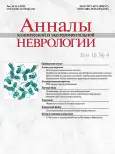Evaluation of the outcome in ischemic stroke acute period
- Authors: Novikova L.B.1, Akopyan A.P.1, Latypova R.F.1
-
Affiliations:
- Bashkir State Medical University
- Issue: Vol 16, No 4 (2022)
- Pages: 5-11
- Section: Original articles
- URL: https://journals.rcsi.science/2075-5473/article/view/124040
- DOI: https://doi.org/10.54101/ACEN.2022.4.1
- ID: 124040
Cite item
Full Text
Abstract
Introduction. As a major cause of both temporary and permanent disability, ischemic stroke is the most common type of cerebrovascular accident (CVA).
Objective. To assess fatal outcome probability in the acute period of ischemic stroke.
Materials and methods. We performed post-hoc analysis of the fatal outcome probability in the patients with acute ischemic stroke at the Neurology Department of the Ufa Emergency Hospital, the Republic of Bashkortostan, Russian Federation. The analysis included data from the randomly selected medical records of 31 patients with fatal outcomes and 55 patients discharged with favorable outcomes.
Results. The patients with fatal outcomes were significantly (p < 0.001) older, with more severe strokes and a higher prevalence of disorders of consciousness, medical co-morbidities, and recurrent strokes as compared to the group of patients with favorable outcomes. Regression coefficients showed that brain herniation, kidney and liver disease, post-infarction cardiosclerosis, diabetes mellitus, and atrial fibrillation were associated with a higher probability of the fatal outcome. Increased severity of disorders of consciousness, NIHSS and mRS scores, specific blood tests values, age, and heart rate were associated with a more probable fatal outcome, while elevated hemoglobin, total protein, red blood cells, and lymphocytes, a higher GCS score, and a history of hypotensive drug therapy were associated with a less probable fatal outcome.
Multivariate analysis showed that the stroke fatal outcome was related with the age, a NIHSS score, and elevated creatinine and total bilirubin levels.
Conclusion. The detected predictors of the stroke fatal outcome can be used as reference points to choose management strategy for patients in the acute period of ischemic stroke.
Keywords
Full Text
##article.viewOnOriginalSite##About the authors
Liliia B. Novikova
Bashkir State Medical University
Email: novicova@inbox.ru
ORCID iD: 0000-0001-8469-1635
D. Sci. (Med.), Professor, Head, Department of neurology, Institute of Additional Professional Education
Russian Federation, 450000, Ufa, Lenin str., 3Anait P. Akopyan
Bashkir State Medical University
Email: ano-akopian@yandex.ru
ORCID iD: 0000-0001-8436-5610
Cand. Sci. (Med.), associate professor, Department of neurology, Institute of Additional Professional Education
Russian Federation, 450000, Ufa, Lenin str., 3Raushaniya F. Latypova
Bashkir State Medical University
Author for correspondence.
Email: rau.lat@yandex.ru
ORCID iD: 0000-0001-7231-8534
assistant, Department of neurology, Institute of Additional Professional Education
Russian Federation, 450000, Ufa, Lenin str., 3References
- GBD 2015 Neurological Disorders Collaborator Group. Global, regional, and national burden of neurological disorders during 1990–2015: a systematic analysis for the Global Burden of Disease Study 2015. Lancet Neurol. 2017; 16(11): 877–897. doi: 10.1016/S1474-4422(17)30299-5
- Бокерия Л.А., Ступаков И.Н., Гудкова Р.Г. Анализ показателей заболеваемости различными формами болезней системы кровообращения в федеральных округах РФ. Здравоохранение. 2015; (6): 66–75. Bokeria L.A., Stupakov I.N., Gudkova R.G. Analysis of incidence rates of various forms of diseases of the circulatory system in the federal districts of the Russian Federation. Zdravookhranenie. 2015; (6): 66–75. (In Russ.)
- Магомаев М.Ф. Прогноз заболеваемости церебральным инсультом в Республике Дагестан. Журнал неврологии и психиатрии им. С.С. Корсакова. 2015; 115(3): 59–63. Magomaev M.F. Prediction of the incidence of cerebral stroke in the Republic of Dagestan. Zhurnal Nevrologii i Psihiatrii im. S.S. Korsakova. 2015; 115(3): 59–63. (In Russ.)
- Чугунова С.А., Николаева Т.Я., Кузьмина З.М. и др. Эпидемиология инсульта в Якутске по данным территориально-популяционного регистра за 2015 год. Дальневосточный медицинский журнал. 2017; (3): 80–85. Chugunova S.A., Nikolaeva T.Ya., Kuzmina Z.M. et al. Epidemiology of stroke in Yakutsk according to the territorial population register for 2015. Dal’nevostochnyj medicinskij zhurnal. 2017; (3): 80–85. (In Russ.)
- Drop B., Kos M., Furtak-Niczyporuk M. Stroke epidemiology based on experience from Krasnik country in eastern Poland. Ann. Agric. Environ. Med. 2020; 27(3): 448–455. doi: 10.26444/aaem/110020
- Ozga A.K., Rauch B., Palm F. et al. Reevaluation of risk factors for time to subsequent events after first stroke occurrence using a new weighted all-cause effect measure. BMC Public Health. 2020; 20(1): 817. doi: 10.1186/s12889-020-08971-4
- Стаховская Л.В., Клочихина О.А., Короткевич И.А., Полунина О.С. Анализ прогностических показателей-предикторов летального исхода у больных инсультом. Астраханский медицинский журнал. 2018; (2): 97–103. Stakhovskaya L.V., Klochikhina O.A., Korotkevich I.A., Polunina O.S. Analysis of prognostic indicators-predictors of lethal outcome in patients with stroke. Astrahanskij medicinskij zhurnal. 2018; (2): 97–103. (In Russ.) doi: 10.17021/2018.13.2.97.103
- Hansson P.O., Andersson Hagiwara M., Brink P. et al. Prehospital identification of factors associated with death during one-year follow-up after acute stroke. Brain Behav. 2018; 8(6): e00987. doi: 10.1002/brb3.987
- Takashima N., Arima H., Kita Y. et al. Two-year survival after first-ever stroke in a general population of 1.4 million Japanese — Shiga Stroke Registry. Circ. J. 2018; 82(10): 2549–2556. doi: 10.1253/circj.CJ-18-0346
- Wu H.H., Chang T.Y., Liu C.H. et al. Impact of chronic kidney disease severity on causes of death after first-ever stroke: a population-based study using nationwide data linkage. PLoS One. 2020; 15(11): e0241891. doi: 10.1371/journal.pone.0241891
- Пирадов М.И., Танашян М.М., Максимова М.Ю. Инсульт: современные технологии диагностики и лечения. Руководство для врачей. М.; 2018. Piradov M.I., Tanashyan M.M., Maksimova M.Yu. Stroke: modern technologies for diagnosis and treatment. Guide for doctors. Moscow; 2018. (In Russ.)
Supplementary files










